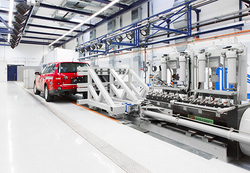New radiation source for X-ray crash X-CC

In X-ray crash testing, EMI has reached the next milestone. With the purchase of a linear accelerator (LINAC), the Fraunhofer-Gesellschaft now has a radiation source at its disposal that distinguishes itself from all other radiation sources so far available with regard to its experimental potential.
With a photon energy of up to 9 MeV, this accelerator exceeds EMI’s current systems by a factor of 20, and all materials that are commonly used in automotive manufacturing can now be X-rayed. Furthermore, a short X-ray pulse duration of a few microseconds enables the recording of deformation processes during crash tests without motion blurring. Most importantly, the LINAC generates a continuous current of X-ray pulses for image creation. By using a continuously emitting radiation source, the currently existing limitation to only few images is outperformed.
These properties beat the path for the first high-speed X-ray video worldwide of a running motorbike engine, which was chosen as object of examination. With an idle speed of 1900 revolutions per minute, the movement of the piston and the motor components are clearly visible. The simultaneous visibility of both massive, highly absorbing motor block parts as well as light components, such as the insulation of the spark plug wires, is particularly noteworthy. This shows the technology’s high range of contrast, which is essential for the visibility of the broad spectrum of materials in the vehicle.